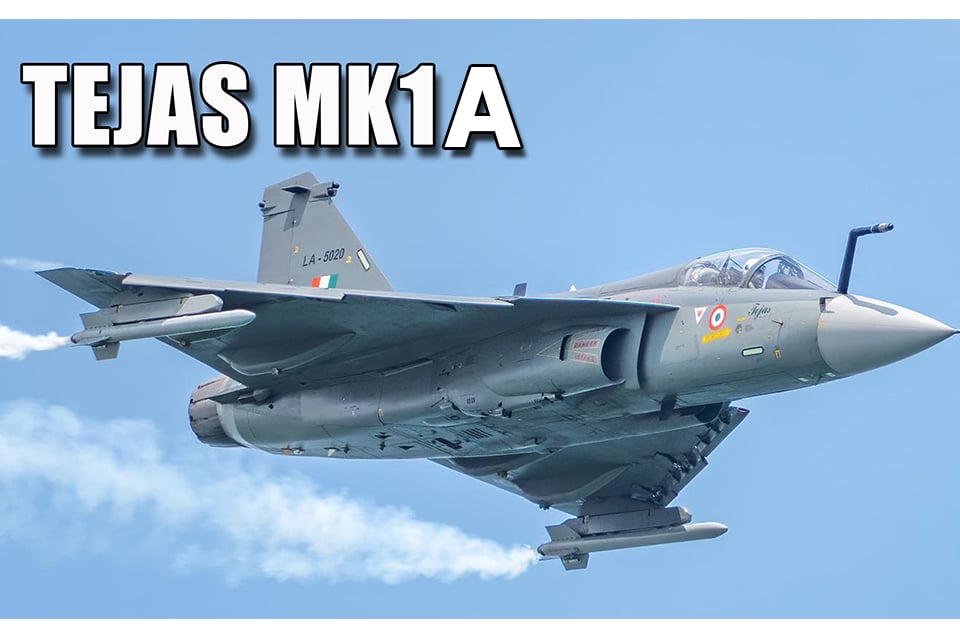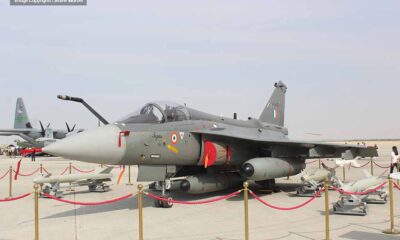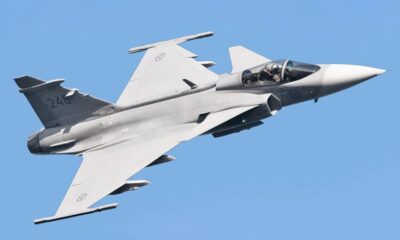Aviation
Malaysia may finalize the negotiations to purchase 18 Tejas fighters.
Huge win for India’s HAL as Malaysia confirmed its purchase of 18 fighter jets and training planes, as reported by the Indian government.

Huge win for India’s HAL as Malaysia may confirm its purchase of 18 fighter jets and training planes, as reported by the Indian government.
According to reports, the deal includes establishing an MRO facility in Malaysia that will also support Malaysia’s fleet of Sukhoi Su-30 aircraft. This will assist in resolving issues brought on by ongoing trade sanctions placed on Moscow in the procurement of spare parts from Russia.
India Since it began producing aircraft jets more than 82 years ago, HAL has maintained the highest technical standards. HAL now possesses a variety of defense aircraft, such as combat and utility helicopters and fighter trainer type aircraft. It is also developing fifth-generation fighter jets.
[the_ad id=”15767″]
According to reports, Malaysia has decided to replace its current fleet of MiG-29 fighter jets with the Indian-made Tejas light combat aircraft and is allegedly in advanced negotiations to finalize its procurement.
Many nations began expressing interest in the aircraft as it was initially presented at the Dubai Airshow, including Argentina, Australia, Egypt, the United States, Indonesia, and the Philippines.
Tejas competed against the Turkish Hurjet fighter jet, although Tejas is already in production and is ready for use. Turkey is at the development stage where its first prototype could be made available by 2023. There is also speculation that the Tejas fighter jet sale was influenced by India’s imports of Palm.
[the_ad id=”15773″]
Four decades after its first approval in 1983, the Indian government last year awarded a $6 billion contract to state-owned Hindustan Aeronautics Ltd for 83 of the locally made Tejas jets, with deliveries to begin around 2023.
As of now, 24 indigenously designed and produced Tejas light combat aircraft (LCA) have been brought into the Air Force’s service. Tejas is a single-engine fighter jet with a delta wing that is 57 percent made in India.
Additionally, India is working on the fifth generation upgraded Medium combat aircraft and the Tejas MK2 variant. which both would later be made available to Malaysia.
By 2025, India hopes to replace its outdated fleet of Mig 21 aircraft. Additionally, Britain declared in April that it would help India’s initiative to produce its own fighter jets. Currently, India possesses a mixture of fighter jets made in France, Britain, and Russia.
[the_ad id=”15765″]
The United States has expressed interest in joining India’s AMCA fighter aircraft programme after France’s saffron engine maker did so, although HAL has not yet officially announced the AMCA‘s engine choice.
In the agreements, HAL has also committed to buying at least 30% of its goods and services from Malaysian businesses. With Boustead Heavy Industries corporations, HAL has a contractual agreement. Should HAL be awarded the Fighter Lead In Trainer-Light Combat Aircraft tender, Depot Level Maintenance, or providing dependability, availability, maintainability, and supportability to the RMAF, would be required.
The remaining stages of the negotiation deals, which are anticipated to occur during the next three months, are almost entirely cleared. This agreement will go down in history as the first defence export deal and evidence of India’s advancement in aerospace technology.
[the_ad id=”15765″]

Aerospace
India is set to build a central command for the Air Traffic Control system, called ISHAN

India’s air traffic growth has led to increased responsibilities for air traffic control. The Airports Authority of India (AAI) is considering centralizing air traffic control for aircraft, dividing the country into four regions. The goal is to consolidate India’s segmented airspace into a single entity to improve air traffic management (ATM) efficiency, safety, and smoothness.
Recently, the AAI invited expressions of interest to develop a detailed project report for the Indian Single Sky Harmonized Air Traffic Management (ISHAN) initiative in Nagpur. Under this plan, air traffic controllers in Nagpur would handle domestic flights flying above 25,000 feet, eliminating the need for coordination among controllers in different regions.
For domestic regional flights operating above 25,000 feet, control would shift to the central command in Nagpur. This consolidation aims to enhance airline operations, increase flight handling capacity, and reduce congestion and flight times for passengers.
Currently, the AAI provides ATM services over Indian airspace and adjoining oceanic areas, covering over 2.8 million square nautical miles. This airspace is divided into four flight information regions (FIRs) in Delhi, Mumbai, Kolkata, and Chennai, along with a sub-FIR in Guwahati.
FIRs are responsible for providing air traffic services, including weather information, visibility, and search and rescue assistance. The proposed unification under the ISHAN initiative aligns with the projected growth of the aviation industry, which anticipates a doubling of domestic passenger traffic by 2030.
Aviation
Airbus is set to increase the production rate for the A350 as demand surges

Airbus SE is set to boost production of its advanced A350 widebody jet as it capitalizes on rising demand for long-distance travel and wide-body aircraft, amidst the ongoing crisis affecting its competitor Boeing due to issues with the B737 Max.
The surge in orders for Airbus’s A350 aircraft has instilled confidence in the company, prompting them to ramp up production rates. This move is particularly advantageous as Boeing continues to grapple with production quality issues surrounding its 787 and 777x aircraft.
In 2024 alone, Airbus has received 137 orders for the A350, signaling a need to expand manufacturing capabilities to meet customer demands. With 1,277 orders received and 592 aircraft delivered as of April 2024, Airbus is poised to fulfill pending deliveries efficiently.
The European aircraft manufacturer announced plans to increase production of A350 jets to 12 per month by 2028, surpassing earlier projections aiming for 10 per month by 2026. This decision was disclosed alongside the company’s first-quarter figures.
The Asian market is proving lucrative for the A350, with significant orders from airlines like Indigo and Air India, totaling nearly 70 aircraft commitments for the future. Meanwhile, Airbus is progressing with its A220 and A320 programs, aiming for a monthly production rate of 14 and 75 aircraft, respectively, by 2026. Additionally, the long-range A321XLR is anticipated to commence service in the third quarter of the current year.
In contrast, Boeing has been compelled to scale back production due to regulatory pressures aimed at enhancing factory processes. While Airbus anticipates a positive market outlook, Boeing continues to face challenges with FAA certification and quality approvals, resulting in ongoing delays for its 737 Max and 777x models.
Financially, Boeing reported a significant cash burn of $3.9 billion in the first quarter, leaving it with $7.5 billion in cash and short-term securities by the quarter’s end, down from $16 billion at the beginning of the year. Consequently, Boeing’s stock has plummeted by 38% in the year so far, contrasting with Airbus’s 14% gain, marking Boeing’s lowest performance in over a year.
For a full listing including details on customers and regions, as well as historical data for the previous year, go to the download section below.
- March 2024 deliveries: 63 deliveries to 32 customers
- March 2024 gross orders: 137
- 2024 deliveries to date: 142 deliveries to 45 customers
| Single-Aisle | A300/A310 | A330 | A340 | A350 | A380 | TOTAL | |
|---|---|---|---|---|---|---|---|
| Total Orders | 19470 | 816 | 1774 | 377 | 1277 | 251 | 23965 |
| Total Deliveries | 11705 | 816 | 1598 | 377 | 592 | 251 | 15339 |
| Aircraft in Operation | 11007 | 271 | 1482 | 202 | 591 | 234 | 13787 |
Aviation
All passengers killed in plane crash, after pilot let his children to control the plane

When boarding a plane, passengers entrust their safety to the skilled hands of the pilot. However, tragedy struck when one of the flight ended in disaster as all passengers lost their lives in a horrific plane crash.
In 1994, during a flight from Moscow to Hong Kong, tragedy struck as an Aeroflot relief pilot made a fateful decision. In a move that would have devastating consequences, the pilot invited his own children into the cockpit to play with the controls. Little did anyone know, this seemingly innocent gesture would lead to the loss of all 75 lives aboard the aircraft.
It was a seemingly innocent act that led to catastrophic results. The relief pilot, Mr. Kudrinsky, invited his two children, Yana, 12, and Eldar, 15, into the cockpit during the late hours of the night. Little did anyone know, this simple gesture would set off a chain of events that would end in tragedy.
Once in the cockpit, the children were allowed to sit in the captain’s chair and play with the controls, unaware that they should have been disabled as the plane was in autopilot mode.
Eldar, perhaps in a moment of curiosity or innocence, held the control column down for a mere 30 seconds. Yet, in those brief moments, the autopilot disengaged, thrusting the aircraft into manual control.
By the time the pilots regained their seats and attempted to regain control, it was too late. Despite their efforts to pull the plane out of a dive, they overcorrected, causing the flight to climb almost vertically, ultimately stalling it.
Final moment Flight 593 crash
In the final moments, as the pilots struggled to stabilize the aircraft, Flight 593 crashed into the Kuznetsk Alatau Mountain range in southern Russia, completely obliterating the plane and claiming the lives of everyone on board.
Investigations revealed a chilling truth: there was no evidence of technical failure. Instead, the crash was attributed to the unthinkable decision to allow inexperienced hands to manipulate the controls of a commercial aircraft.
The black box recording captured the harrowing sequence of events, providing a grim reminder of the human cost of a lapse in judgment. In just over two minutes, the lives of all on board were tragically short, leaving behind a legacy of sorrow and unanswered questions.




























